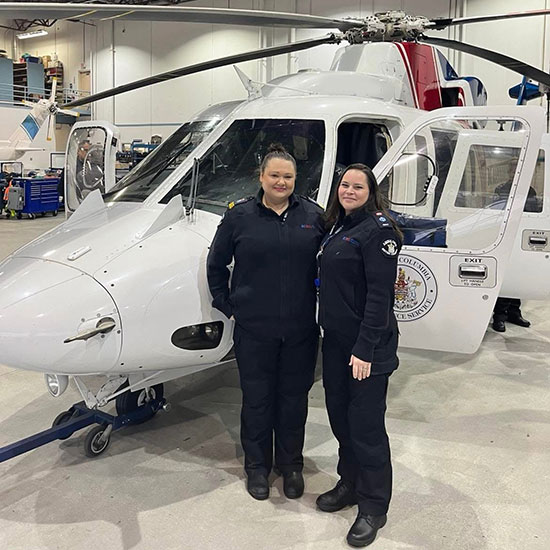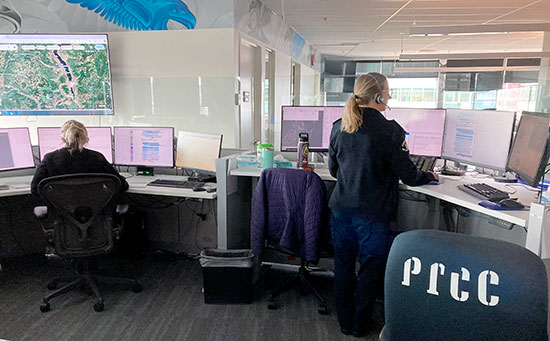by Karla Wilson
When people think of BC Emergency Health Services (BCEHS), they often picture ambulances rushing to an emergency with lights flashing and sirens blaring. However, BCEHS is involved in much more than just responding to 9-1-1 calls.
One essential, yet often unseen part of their work takes place through Patient Transfer Services (PTS), a department responsible for the safe and timely coordination and transfer of patients between healthcare facilities across British Columbia.
These transfers can range from routine moves for diagnostic tests to urgent, complex life-saving transfers from smaller hospitals to larger, specialized care centers. Whether these transfers are urgent or not, the work done by the team at BCEHS’s Patient Transfer Services is critical to ensuring that patients receive the care they need, wherever they are in the province.
Patient Transfer Services (PTS) at BCEHS oversees the movement of patients between hospitals and other healthcare facilities in the province. PTS is made up of two main components: the Patient Transfer Network (PTN) and the Patient Transport Coordination Centre (PTCC)
The two departments were combined in 2012 so that PTS could focus on a patient’s complete journey from planning to logistics. They work closely together to coordinate all aspects of a patient’s transfer, ensuring that the right resources are available, and that the process is seamless and efficient.
Together, the Patient Transfer Services’ team of approximately 140 people manage about 75,000 transfers per year, including over 8,500 air transfers using helicopters and fixed-wing aircraft.
The Patient Transfer Network (PTN) is the backbone of the transfer process. When a patient needs to be moved between facilities, PTN is responsible for coordinating the transfer. This team works closely with hospitals, doctors, and ambulance services to make sure that the patient is transferred to the right place and with the appropriate care.
Any urgent transfers must go through PTN. They coordinate finding an accepting physician and site, which is critical when every second counts.
The PTN team handles a wide range of transfers, from calls for routine medical appointments to emergencies like trauma or critical illnesses.
Lindsay Perkins, a Charge Interfacility Emergency Medical Call-Taker (I-EMCT) with PTN, celebrates 20 years of service this year with BCEHS. Lindsay’s career started as an interfacility emergency medical call-taker, and she was promoted to the charge position in 2023.
"When I first started, we were a small office with only five people," she says. “The scope of our work has really increased over the years and now we’re fully staffed with 17 people on day shifts and five people on night shifts.”
Lindsay says the work is as challenging as it is fulfilling.
"I like to know that I’m helping make a difference in a patient’s life, especially when they’re at their worst," she explains. “We get calls to coordinate interfacility transfers for trauma and have dealt with patient events like bear attacks, helicopter crashes, and patients who are skiing and get stuck in wells and avalanches.”

L to R: Interfacility-Emergency Medical Call-Takers Lindsay Perkins and Candice Dunsmore touring the Critical Care Transport (CCT) Station in the Vancouver International Airport
Once the Patient Transfer Network has coordinated a transfer, the responsibility passes to the Patient Transport Coordination Centre (PTCC). The PTCC takes charge of logistics, dispatching ground ambulances and coordinating air ambulances. This is where the technical aspects of patient transfer come into play.
Interfacility Emergency Medical Dispatcher (I-EMD) Dave Stevens has worked for BCEHS since 1990 – first as a paramedic, then as an emergency medical dispatcher. He has worked at PTCC for the past 12 years.
“With this role, it’s like a never-ending inbox – stuff keeps coming in and we have to multi-task more so than as a paramedic,” he says. “You don’t get to focus on one thing in front of you and you’re balancing and re-prioritizing all the time. We are constantly juggling resources.”

Caption: Interfacility Emergency Medical Dispatcher Dave Stevens
The PTCC works closely with pilots, ambulance crews, and medical teams to make sure the patient is moved safely and efficiently. For example, when a patient needs to be transported from a remote northern community to a trauma center in Vancouver, the PTCC ensures that the right type of ambulance or air ambulance is available and that medical crews are equipped to handle the patient’s specific needs.
“Because we are the only dispatch centre dealing with the whole province, we have a diverse set of clients and client needs,” Stevens explains. “We have to think about things like remote access and logging roads and we deal with a lot of very small clinics. It’s a very different set of resources and client needs than what you’d see in, say, a metropolitan emergency dispatch centre. A lot of these calls can take six to eight hours.”
Critical Care Paramedic and Infant Transport Team advisors, two of the highest levels of paramedic experience, are recent new additions to the PTCC staff complement. These advisors participate in calls concerning patients and work with PTN and PTCC from a clinical lens.
BCEHS has a dedicated fleet of around 30 transfer ambulances in the Lower Mainland, along with additional transfer ambulances on Vancouver Island and in the Interior. These ambulances are specifically deployed to transfers, enabling timely patient movement between hospitals while minimizing impact to pre-hospital resources.
In addition to ground transport, BCEHS also operates a helicopter and fixed-wing aircraft fleet, which is crucial for moving patients in and out of remote or hard-to-reach areas. Coordinating air ambulance resources requires careful planning: pilots must conduct weather checks, ensure the right crew is available, and account for timing and distance.
One of the key aspects of PTS work is repatriating patients back to their home communities once they’ve received the necessary treatment. This involves coordinating patient transfers from major hospitals back to local facilities, ensuring that the patient continues to receive the appropriate level of care closer to home.
Once a patient has been treated, they can be moved back to their home community for continued hospital care. This process helps reduce the strain on urban hospitals while ensuring patients can continue their recovery near their families.
The team working behind the scenes at PTN and PTCC are deeply aware that every transfer represents a life.
In the event of traumas and emergencies, Interfacility Emergency Medical Call-Taker Lindsay Perkins says she can separate her own emotions from the job at-hand and lean on her own emotional resilience.
“I just remember I’m the person they’re calling to get help from,” she says. “They need me right now, so I need to keep it together. I do whatever I can to help the patient get to the care they need.”
Interfacility Emergency Medical Dispatcher Dave Stevens says he sees the job of the PTCC as critical to ensuring positive patient outcomes.
“If you think of all the other bit players in this whole thing we do – everything from the medics, hospitals, doctors, patients, and pilots – they all have their own important role,” he says. “I liken them to being on the outside of a bicycle wheel with PTS right in the middle – it’s the hub. We’re the ones that interact and see what everyone else is doing. We keep everyone on the same path.”
During the COVID-19 pandemic, the work of PTS was more critical than ever, as patients needing critical care were transferred to hospitals, mostly in the Lower Mainland, from all over the province.;
“It was overwhelming to be flooded every day with at least one to two patients each shift who were sick with COVID during the pandemic — and very, very sick,” Stevens says. “Every day, we saw people who were young and otherwise healthy. The bigger problem at our end was these calls took an exceptionally long time because of the extra steps involved: all the personal protective gear, pre-gowning the back of the aircraft, and the calls took longer. One Covid call would be an entire shift – that’s a 12-hour call. And the medics got hit the worst. The whole time they were in full protective gear.”
BCEHS recently created a new, dedicated space for PTN and PTCC staff, who now work together in the same physical location. The staff work in shift patterns and rotate between day and night shifts so that the centre is staffed around the clock.
The coordination, logistics, and expertise that go into ensuring patients are transferred safely between healthcare facilities and back to their home communities is an essential and often invisible part of BCEHS’ work. Both Lindsay and Dave agree that their work is meaningful and important.
“It’s fascinating to be part of the journey and knowing we’re making a difference in people’s lives,” Lindsay says. “It’s rewarding work, and I feel like we get a lot accomplished in a 12-hour shift.”
“I am able to do a job where I’m able to give of myself and help other people,” Stevens says. “I get to be a small bit player in a huge, complex machine. The fact that I get to be part of that team and contribute and do some good is like being on a winning team. It’s very rewarding.”
“There’s no greater thing in life than to attend to others in their time of need.” - Dave Stevens

Patient Transfer Coordination Centre workspace in April 2025
This year, we celebrate National Public Safety Telecommunicators Week (NPSTW) from April 13-19. As we celebrate both NPSTW and our organization’s 50th anniversary, the PTS leadership team wants to recognize the incredible work done every day by the teams in PTN and PTCC.

Patient Transfer Network workspace in April 2025
Whether it’s coordinating complex transfers or managing high-pressure situations, this team consistently comes together and puts the patient first. The work you do matters, you make a real difference and play a vital role in our organization. Thank you for everything you do!
